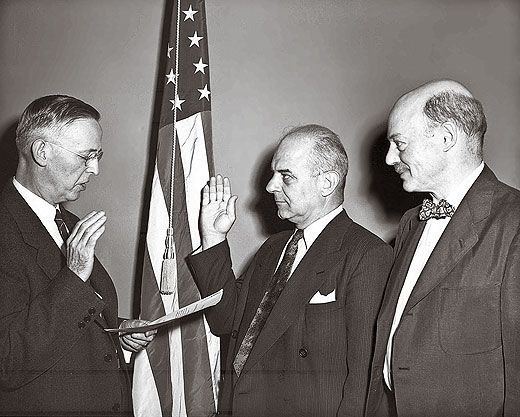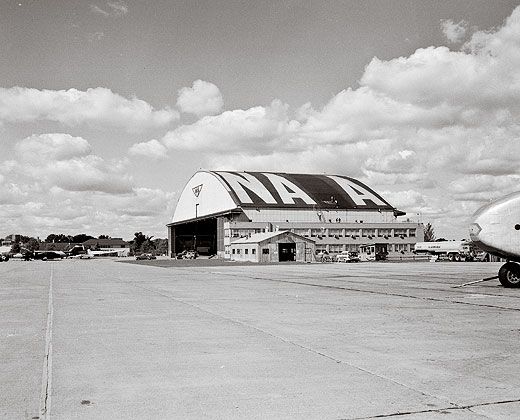I Was There: “The Tremendous Potential of Rocketry”
Jimmy Doolittle remembers the birth of the U.S. space program.
/https://tf-cmsv2-smithsonianmag-media.s3.amazonaws.com/filer/The-Tremendous-Potential-of-Rocketry-9-1-2012-1_FLASH.jpg)
On April 21, 1969, three months before the first Apollo moon landing, NASA historian Eugene M. Emme, together with William D. Putnam of the NASA historical staff, interviewed U.S. Air Force General James H. Doolittle, chairman of the National Advisory Committee for Aeronautics from 1957 to 1958, when it was dissolved to form the National Aeronautics and Space Administration.
DOOLITTLE: A little background on the wisdom of the people who established the NASA of kicking all of us old restricted thinkers out and getting some new folks with greater vision in: I gave a talk about Dr. Robert Goddard at a conference by the American Rocket Society, in which a large number of people who were interested in rocketry were assembled in New York. This was shortly after World War II, at a time when we had not yet given much credence to the tremendous potential of rocketry, and some of us in the airplane business looked with a slightly raised eyebrow at some of these rocket people, who seemed to us to be unduly enthusiastic. While there were undoubtedly geniuses among them, most of us looked at them as starry-eyed.
NACA was more free from political intervention than probably any other governmental organization. As a consequence, the NACA was able to carry out its mission, with the only problem being the acquisition of funds each year. For this, it was necessary for the director and chairman to go before Congress. This was a unique situation, one that those of us who had long been with the NACA disliked very much to give up. This was, I think, more than anything else the reason for a reluctance on the part of the NACA to be converted into the NASA.
EMME: I often wondered how John F. Victory [a longtime NACA executive] and Hugh L. Dryden [late-term NACA chairman and NASA deputy administrator] worked so closely in the internal operations of the NACA. Victory helped the NACA time and again, doing things on Capitol Hill that Dryden wouldn’t touch with a long pole.
Hugh Dryden was a very shy person. You had to come to Hugh to get him to open up. John was very outgoing and quite uninhibited. Sometimes it was necessary to shout. Hugh did not have it in him to shout. John did. So they worked together very well. John had an association with the NACA since its inception [1915], and remembered everything and everybody.
EMME: What do you remember about presiding over the committee meetings?
I have sat as chairman of a great many committees but I don’t know anywhere the job was as pleasant and free from abrasion as in the old NACA. You had the weather department, the Army, the Navy, the Army Air Corps, the Bureau of Standards, the Smithsonian. Tremendously diverse agencies, but the way in which that group worked to produce superior aircraft and equipment was absolutely amazing. Somebody way back in the NACA developed the habit of making this an organization that worked for the betterment of the country and not any individual group. I don’t remember ever having had a real conflict between the Army and the Navy.
EMME: Does Jerome Hunsaker [NACA chairman from 1941 to 1957] still have the view of rocketry as in 1957? He told Theodore von Kármán [head of the Guggenheim Aeronautical Laboratory]: “You can have that Buck Rogers stuff.”
Well, some of us never learn, but I’ve learned.
EMME: Were you involved with Hugh Dryden and the “young Turks” of the NACA, where he kept out the top people and let the younger chaps let their hair down and look at the space challenge to see whether they wanted to get in?
While we did not actually say “You young fellows stand on one side and you old gentlemen on the other,” there was an effort to get the ideas of the young people. There were honest differences of opinion between laboratories, between people, between young and old. I think you will find these same differences of opinion in most American homes. It is only when they become destructive rather than constructive that harm is done.
PUTNAM: People have said the Air Force had gone in the wrong direction after World War II in looking to the pilotless bomber as an intercontinental striking force to augment the manned bomber, and had ignored the ballistic missile. Almost everyone in the scientific community advising the Air Force agreed that [a cruise missile], the Snark and the Navajo, would be the most proper to pursue.
Most of us saw in the subsonic piloted aircraft a means of getting range promptly that we did not see in the ballistic missile. The concept at the time was with the directed pilotless aircraft. A military capability could be achieved with greater speed than by the missile, which seemed farther away and had unknown problems, whereas the guidance, power plants, and the fuselage and wing structure [of aircraft] were known.
PUTNAM: A major figure in getting the ballistic missile program started was [assistant secretary of the Air Force] Trevor Gardner.
Benny Schriever [an Air Force general who headed the division responsible for creating the intercontinental ballistic missile] worked closely with Trev Gardner and Johnny Von Neumann [a Hungarian-American mathematician who worked on the Manhattan Project]. The unique thing he did—Gardner and Von Neumann conceived it—was to take a lot of unknown things and develop them in parallel. In the early days of aviation, the two principal parts of the airplane were the structure and the engine. You designed the structure to the engine available. “Now we will put on the necessary military equipment.” You installed the guns or bombs, the photographic and navigation equipment. By the time you got through, it was a clunker. You had to put bulges on the airplane to get the stuff in, the absolute opposite of systems engineering. With Schriever it was possible to start many things at the same time and have them all introduced into the complete vehicle, ready to go as early as possible.
PUTNAM: It sounds simple in the abstract but it is complicated in the doing.
Systems engineering had some very difficult human-equation problems. You had to have someone with the authority to give the whip to the chap who was lagging and say, “You either get on with this and we will give you some people to help you, or we will give it to someone else.” This was a terrible decision to make, because that guy may have spent six months getting as far as he was. So you had to make a decision: Is this chap completely incompetent and do you have to start all over with someone else? Benny solved the problems in this new concept one by one. Si Ramo and Dean Wooldridge [who would go on to form Thompson Ramo Wooldridge, later known as TRW] were a great help to him in setting up this system.
Perhaps best known for winning the Schneider, Bendix, and Thompson air race trophies, making the first “blind” takeoff and landing by relying solely on instrumentation, and in 1942 leading the first air campaign against Japan, Doolittle also was a director of Shell Oil and TRW and in 1985 was named a four-star U.S. Air Force general. He was the last chairman of the NACA, and in 1958 he turned down an offer to serve as the first administrator of NASA.

